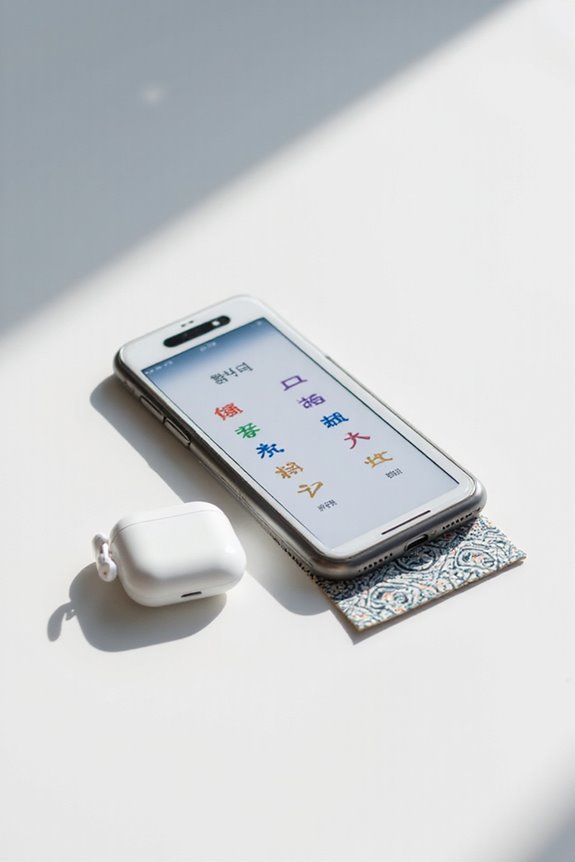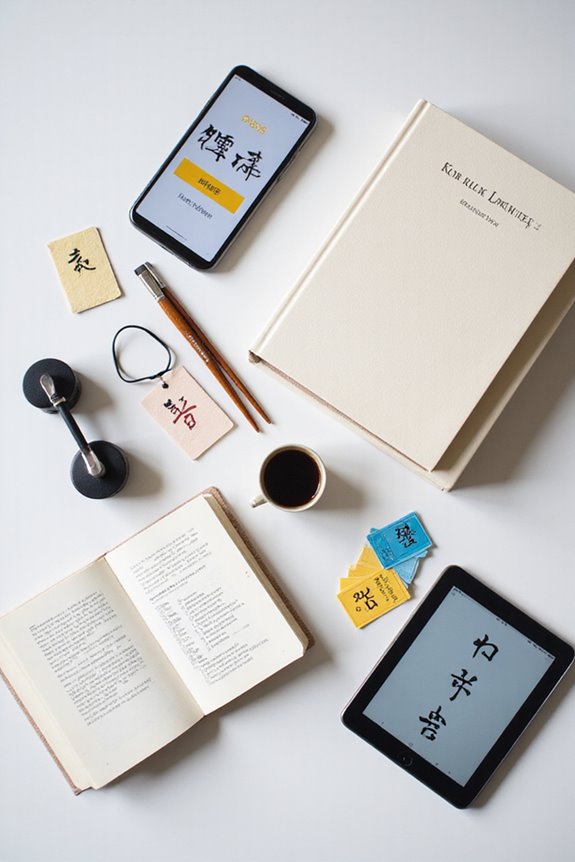Korean language study plans are organized approaches that help us focus on language goals, effective strategies, and appropriate resources. We can set specific, achievable objectives, like passing the TOPIK level 2 exam. A well-designed curriculum should consider our unique interests and cultural contexts. Incorporating varied learning tools and techniques, such as flashcards, media immersion, and conversation practice with natives, enhances proficiency across writing, speaking, listening, and reading skills. Learning about personalized plans can lead to greater success.
Key Takeaways
- Korean language study plans include specific language goals, such as passing TOPIK level 2 or having daily conversations in Korean.
- Effective learning strategies incorporate consistent practice, language immersion, and engaging with native speakers through language exchanges.
- A well-designed curriculum should align with learners’ goals and incorporate cultural context, focusing on listening, speaking, reading, and writing skills.
- Time management techniques, like time blocking and the Pomodoro technique, help optimize study sessions for language acquisition.
- Overcoming challenges, such as language anxiety and limited resource access, requires community support and adaptive learning strategies.
Understanding Language Goals in Korean Study Plans
When we commence our Korean language studies, it is important to understand that clear language goals play a significant role in our overall success. Setting realistic and achievable language goals is essential; for instance, aiming to pass TOPIK level 2 can be both motivating and attainable. We should avoid overly ambitious targets like achieving native-level fluency quickly. Specificity in our goals is equally important; instead of stating we want to improve speaking skills, we can say, “have a 10-minute conversation in Korean daily.” By breaking down our goals into manageable milestones and aligning them with our personal motivations, we can enhance our learning experience. Utilizing goal setting techniques and motivation strategies helps maintain focus on our progress throughout this educational journey. Incorporating structured study plans can also improve efficiency in preparing for exams like TOPIK.
Effective Learning Strategies for Korean Mastery
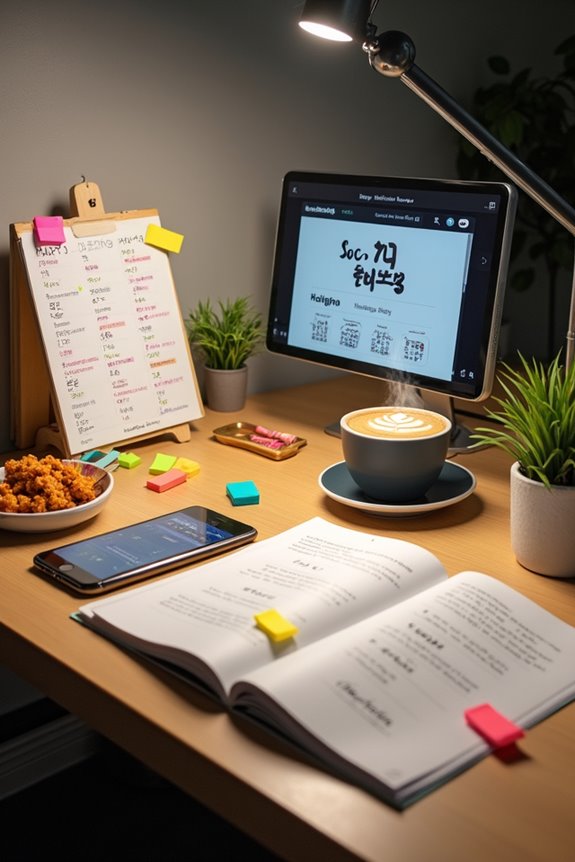
To achieve mastery in the Korean language, we must adopt effective learning strategies that incorporate consistent practice and diverse resources. Engaging in language immersion through daily interaction with Korean media, such as K-dramas or K-pop, helps us absorb natural expressions and improve pronunciation. Regular reading of Korean webtoons or books also enhances comprehension and contextual understanding. For vocabulary retention, we can utilize flashcards and mnemonic devices to reinforce learning. Setting clear goals allows us to track progress and stay motivated. Incorporating technology, like language learning apps and podcasts, facilitates flexible study. In addition, engaging with native speakers through language exchange can greatly enhance our conversational skills, providing practical experience in real-life contexts. Using educational products like flashcards can also significantly boost our vocabulary acquisition and retention.
Designing a Curriculum for Korean Language Acquisition
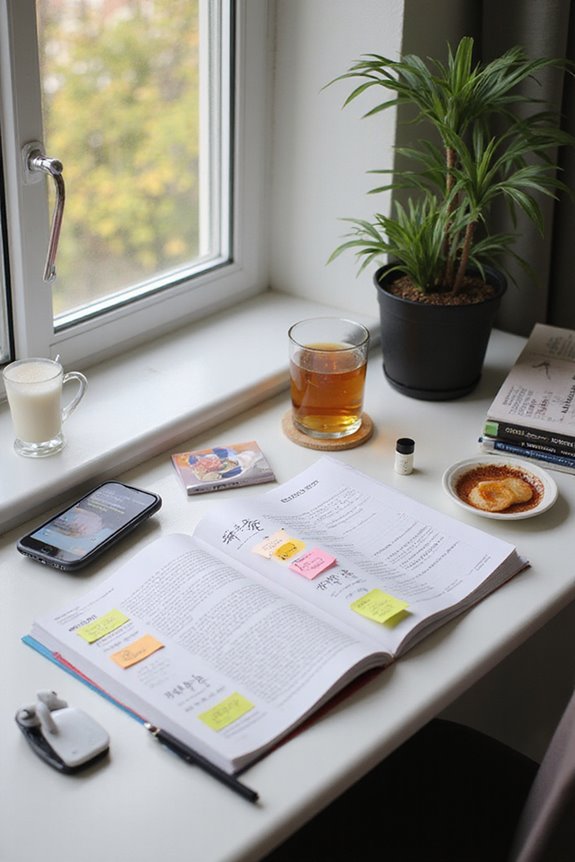
Designing an effective curriculum for Korean language acquisition requires a thoughtful approach that aligns with learners’ varying needs and goals. We need to take into account both general communication skills and specialized tracks, such as business Korean or thematic interests. A well-structured curriculum typically includes levels like beginner, intermediate, and advanced, accompanied by appropriate textbooks and conversation practice to foster language proficiency. Integrating Korean culture into the curriculum enhances contextual understanding, making learning more engaging. Content-based instruction, utilizing authentic resources such as films and literature, is essential for deepening language skills alongside cultural literacy. Our lesson plans must emphasize the core areas of listening, speaking, reading, and writing, ensuring curriculum alignment with standardized objectives for measurable outcomes. Additionally, incorporating supplementary materials such as audio support can significantly enhance the learning experience.
Time Management Techniques for Language Learning
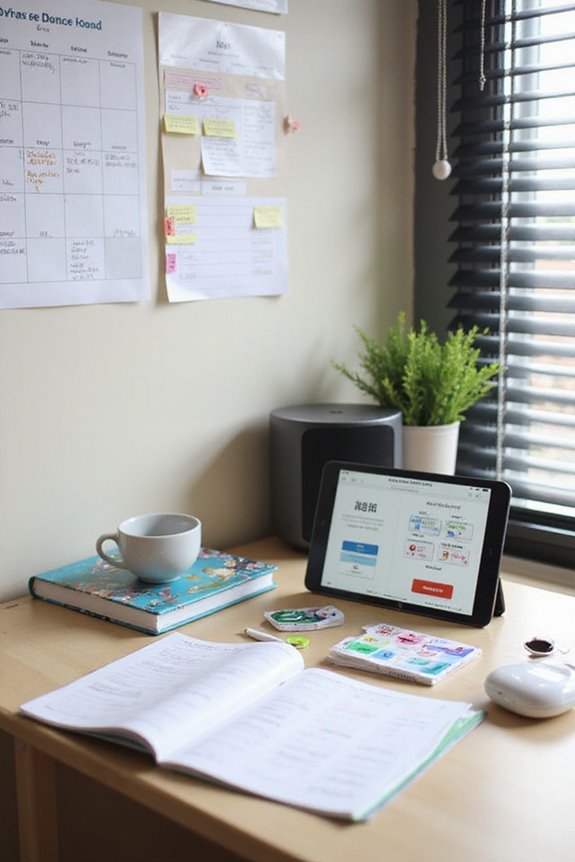
While effective time management is essential for acquiring a new language, implementing specific techniques can greatly enhance our learning experience. One effective method is time blocking, where we dedicate exclusive slots for study. This can involve focused sessions of 15 to 30 minutes, helping us avoid distractions and maintain consistency. We can also utilize microlearning, focusing on short activities during busy moments to improve retention without overwhelming ourselves. Finding our ideal times for study, such as mornings, can boost our productivity. Additionally, using the Pomodoro technique allows us to work in focused 25-minute intervals, followed by short breaks. Finally, integrating language practice into daily life, like engaging with Korean media, accelerates our proficiency and cultural understanding.
Essential Tools and Resources for Studying Korean
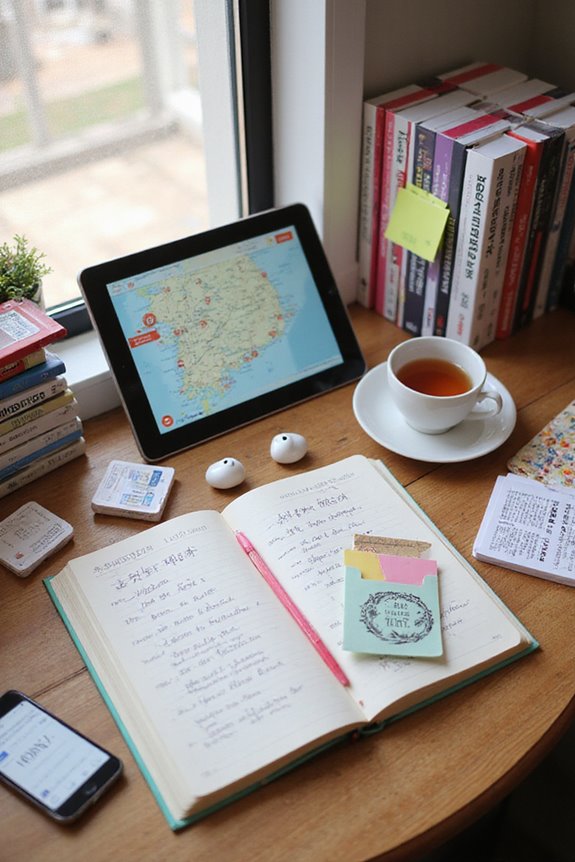
Effective time management techniques set a solid foundation for our Korean language learning journey, but selecting the right tools and resources can considerably further our progress. Dictionary apps like Naver and Daum provide valuable translations, real-life example sentences, and robust grammar checkers that enhance our understanding of the language. Additionally, language exchange platforms such as HelloTalk and Tandem allow us to practice speaking with native speakers, reinforcing our conversational skills. For extensive grammar support, tools like Naver Spelling Machine can correct errors in our writing. Finally, immersing ourselves in cultural resources, like Korean webtoons and podcasts, offers exposure to everyday language and context, making our learning experience richer and more engaging. Incorporating interactive learning features into our study routine can also significantly boost retention and engagement.
Assessing Progress and Evaluating Proficiency
Evaluating our progress in learning Korean is essential to guarantee that we’re on the right track toward achieving proficiency. To properly gauge our development, we can utilize proficiency assessments like the TOPIK and ACTFL exams, which measure essential language skills, including reading, writing, listening, and speaking. Progress tracking can be enhanced through regular placements tests that identify our current level and tailor our learning plans accordingly. For example, the TOPIK divides proficiency into beginner and advanced sections, helping us understand which areas require further focus. Additionally, integrating interim assessments allows us to monitor our skills over time, ensuring we address weaknesses before formal evaluations, thereby making our Korean studies more effective and targeted.
Incorporating Cultural Immersion in Language Learning
Incorporating cultural immersion into our Korean language learning journey is essential for enhancing both linguistic skills and cultural understanding. By changing our electronic device language settings to Korean, we create daily exposure, while labeling household objects reinforces vocabulary. Cooking authentic Korean cuisine offers experiential learning of culinary terms and practices. Engaging with Korean media, like K-dramas and podcasts, helps us develop listening skills and cultural context. We can leverage online resources, connecting with community members for cultural insights while exploring children’s books and TV shows. Finally, participating in local cultural events further facilitates cultural integration, providing opportunities to practice language in rich, contextual situations, making our learning experience more thorough and relatable. Additionally, understanding cultural nuances in business etiquette can greatly enhance our interactions within Korean-speaking environments.
Customizing Study Plans Based on Personal Interests
With a clear understanding of our personal interests, we can design Korean language study plans that engage and motivate us effectively. By selecting tailored topics based on our hobbies, such as food or music, we can match vocabulary to those interests for improved retention. Integrating media relevant to our passions, like Korean dramas or cooking shows, helps in authentic exposure. We can customize our syllabus to cover various themes, ensuring a dynamic approach to language learning. Setting achievable mini-goals, such as learning specific terms or writing about our interests, reinforces our commitment. By rotating resource types, we maintain engagement, while using real-life materials fosters practical application, thereby aligning our studies with everyday contexts and personal enrichment. Additionally, incorporating practical expressions into our study plans can enhance our conversational skills in real-life situations.
Balancing Skill Areas: Writing, Speaking, Listening, and Reading
Achieving a balanced proficiency in Korean requires us to simultaneously develop our writing, speaking, listening, and reading skills, as neglecting any one area can hinder overall language acquisition. Incorporating daily writing practice, such as journal entries, helps build vocabulary and syntactic accuracy. For speaking, we engage in conversation strategies with peers to enhance spontaneous dialogue skills and improve pronunciation. Listening exercises, including podcasts and dramas, expose us to natural speech, while reading comprehension activities, like varied article types, reinforce language structure. Skill integration is essential; we can use interactive tools that combine these elements. Establishing feedback loops involves evaluating our progress, enabling us to adjust our focus and prioritize vocabulary expansion across all areas effectively.
Overcoming Challenges in Korean Language Studies
While balancing skill areas in Korean language study is vital, we must also address the myriad of challenges that learners typically encounter. Language anxiety often hinders our progress, particularly as we face complex concepts such as honorifics and syntax. Additionally, resource accessibility remains a significant barrier; many learners lack high-quality materials like textbooks and apps, especially in developing regions. This scarcity can lead to frustration and attrition. Furthermore, limited opportunities for structured learning, such as qualified instructors and language labs, further complicate our studies. It’s essential that we adapt our strategies, utilize available online platforms, and seek community support to overcome these challenges. By doing so, we can enhance our learning experience and persist in achieving fluency.
Frequently Asked Questions
How Long Does It Take to Learn Korean Effectively?
Learning Korean effectively takes time, and our study duration largely depends on consistency. With daily practice and dedication, we can achieve basic conversational skills in about three months, while fluency may require several years of commitment.
What Are Some Common Mistakes Beginners Make in Korean?
When we’re starting Korean, we often face pronunciation pitfalls, like confusing similar sounds, and grammar errors, particularly with particles. Acknowledging these common mistakes makes our learning journey smoother and more rewarding. Let’s practice together!
Are Language Exchange Partners Helpful for Learning Korean?
Finding language exchange partners can be a delightful journey, fostering cultural immersion and enriching our Korean learning. They’re incredibly helpful, offering real-time feedback and genuine conversations that ignite our motivation and enhance our fluency.
How Can I Stay Motivated While Learning Korean?
To stay motivated learning Korean, we should focus on goal setting and creating reward systems. By celebrating small achievements and having clear objectives, we can make our language journey enjoyable and fulfilling together.
What Are the Differences Between Formal and Informal Korean?
When we think about differences between formal speech and casual conversation in Korean, it’s like choosing between a tuxedo for a gala or comfy jeans for a coffee run. Each has its own unique charm and usage!




